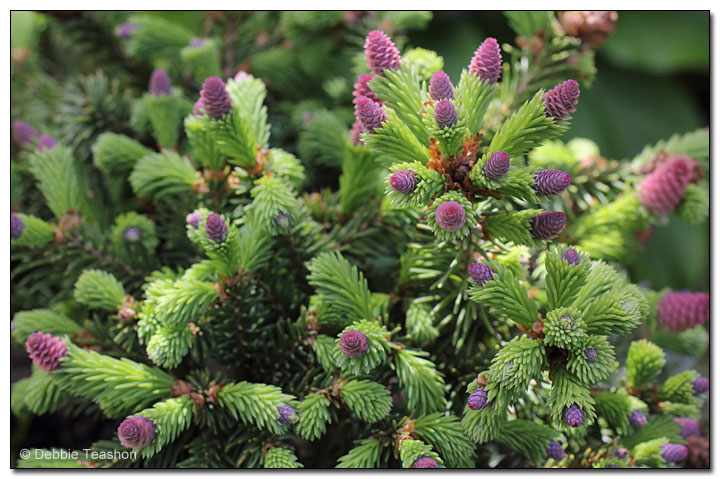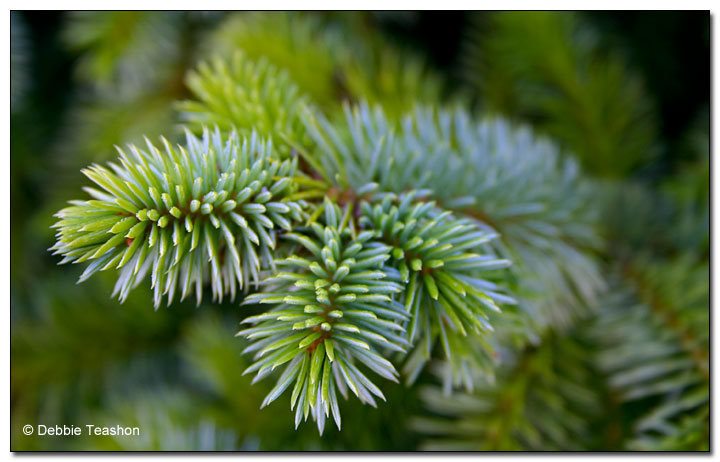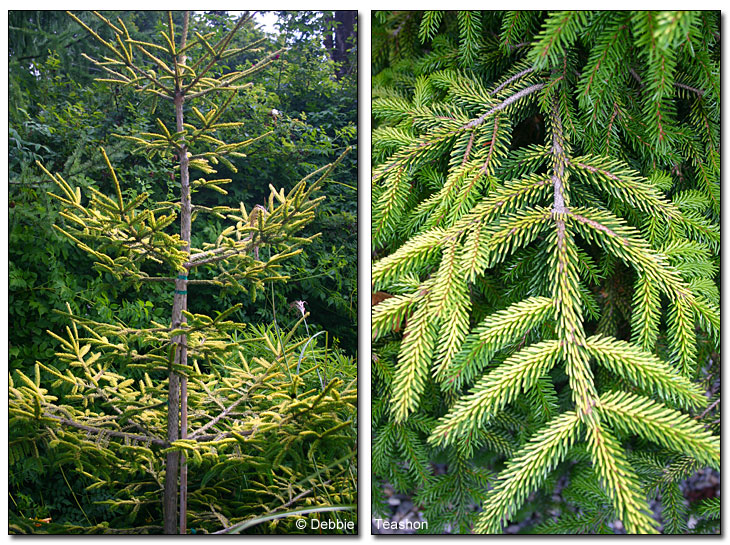A spruce for any landscape

Versatility and deep selection have made the genus a top seller for Oregon growers
With about 35 species, a plethora of cultivars, and all its uses that shape our world, it’s not surprising that trees in the Picea genus are a popular landscape plant and top sellers over other conifers. What’s more, Oregon sells 35% of the spruce trees sold nationally.
There are many stories about spruce trees being an essential resource in American history. Measured ounce per ounce against high-tensile steel strength, spruce lumber is stronger.
In fact, the straight grain lumber from spruce trees took the Wright Brothers into the air at Kitty Hawk on that famous December day in 1903. The brothers’ plane utilized wing-warping for lateral control that literally twisted the wooden beams.
The lightweight wood is durable and capable of flexing. Although not used for planes anymore, the Northwest native Sitka spruce (Picea sitchensis) is still the go-to lumber for ship masts and spars for custom wooden ships.
What about spruce for beer? Europeans learned from Canadian indigenous people that some conifers helped prevent a vitamin C deficiency that caused scurvy. Historically, the British Royal Navy added the needles to their shipped-brewed beer to prevent the disease on long voyages. The French also used spruce over other conifers because it had the highest vitamin C content. Spruce beer made from new-growth needles is brewed today for a refreshing cola taste without the sweetener.
In all shapes, sizes and colors
Setting history and the beer aside, there are good reasons why Spruce trees are prevalent in landscapes today. The market carries a wide assortment of unique and exciting Picea species and cultivars to fit any landscape, nearly any place in the United States.
Need a conifer that fits a small lot? There’s spruce for that. Have homeowners’ association (HOA) height-restriction woes? Spruce has the homeowner covered. Want colorful needle foliage? Spruce will paint the landscape in a rainbow of hues.
Looking for an unusual conifer only a collector could love? The genus gives you that too. And don’t forget the weepers, creepers, and even some twisters.
The Picea group is a big seller because it has so much variability, especially in climates that don’t have as many options as the Northwest.
“I think it comes down to a desire for options in climates with extreme cold,” said Roby Babcock, director of marketing at Iseli Nursery in Boring, Oregon. “It’s not to say there isn’t variability within other groups of conifers — but there’s quite a wide range in the Picea group for those climates. Spruce can take cold and heat, and comes in a wide variety of heights and widths, colors and textures, and provides many opportunities for different landscape applications.”
Dave Grotz, owner of Peace of Mind Nursery Inc. in Silverton, Oregon, appreciates the genus because all colors are represented. Good examples are Picea ‘Mission Blue’, one of his favorite blue spruces, and ‘Skylands’, which he likes for its golden hue in an upright form.
“Sometimes plants fall under the category of being a chamaeleon,” Grotz said. “In that I mean, it changes color with the season. For example, Picea abies ‘Argenteospicata’ (silvertip Norway spruce) has new gold growth in spring. As it flushes out, the new growth is gold, over the older green, and is really pretty.”
The skinny, 3-inch long, pink cones develop on the upper portion of the tree.
The silvertip Norway spruce began as a seedling selection back in 1800 in Germany. It’s almost identical to the species, except for the bright flush of color in spring.
“Another chameleon is Picea abies ‘Cruenta’, which now is in its heyday,” Grotz said. “All the new growth is red. I call this ‘Christmas in April.’ We sold a bunch of them this year.”
Grotz advises bringing the pyramidal conifer out for customers to view no later than the end of March, so when it breaks bud, all the new red growth flushes out — an excellent time to sell them. After the red fades back to green, the show is over.
“Some spruces are maintenance free, but others benefit from pruning,” he said. “This is one that would be a better specimen type plant and show more red foliage by ample pruning. It will back-bud more and grow out more branches, which on ‘Cruenta’ you definitely want to do. The more full it is, the more red it is.”
Grotz warns that information on the web is not always reliable, especially regarding the size. “It’s a fast-growing spruce,” he said.
Babcock appreciates the color variety of spruces as well. “People really like the color, particularly with Picea pungens,” he said. “The blue is a really popular color. It stands out.”
Picea abies ‘Pusch’, a witch’s broom from P.a. ‘Acrocona’, produces outstanding bright red cones over its short branches every spring and remain decorative even after the cones age to brown. A young globose ‘Pusch’ is slow growing at two to four inches a year, and with age, the small spruce grows more broad and upright.
Spruces for small lots
With the trend towards smaller lot sizes in new home construction, many homeowners look for smaller conifers that won’t overwhelm the lot.
Weeping white spruce (Picea glauca ‘Pendula’) is a popular seller at Iseli Nursery, and they call it a real showstopper.
“We have a specimen on the property that’s about 40 years old; it’s quite stunning.” Babcock said. “The weeping white spruce is popular, especially for smaller urban lots. It creates a lot of impact without taking up much space.”
Iseli’s specimen is about 40-feet tall with a small footprint of about 4-feet wide.
“One of the things about this spruce tree is, it’s important for many northern states,” Babcock said. “They don’t have as many options as the West Coast, with the milder climate, in regards to different choices in height, width, color, and texture.” Three dwarf spruces, which grow at a slow pace, are popular sellers at Iseli Nursery:
The nursery considers Picea abies ‘Tompa’ a superior alternative to Alberta spruce.
Picea glauca ‘Jean’s Dilly’ has short, thin needles and was named after Jean Iseli. And measures 2.5 feet tall and 16 inches wide — a dwarf mutation of a dwarf Alberta spruce (Picea glauca ‘Conica’).
The pyramidal P. glauca, Rainbow’s End®, is a color mutation on P. glauca var. albertiana ‘Conica’. A ten-year-old specimen reaches 3 feet tall by 2 feet wide. The new growth is light green. “[It has] a second flush of nice lemon-yellow color in midsummer,” Babcock said.
Jay Sanders, sales manager at KG Farms in Woodburn, Oregon, considers Picea pungens ‘Candlelight’, another dwarf Alberta spruce, one of his favorites. “The flush is yellow and flashy in spring,” he said.
The pyramidal Picea pungens ‘Baby Blue Eyes’ is a KG Farms best seller.
“From a grower’s perspective, it’s an easy plant to grow,” Sanders said. “It doesn’t have issues with disease, and doesn’t need a lot of trimming as compared to other blue spruce. We have to manicure others after their flush, this one grows fairly straight, it’s full, and it doesn’t need extra help.”
Originally from Holden Wholesale Growers in Silverton, Oregon, the seedling was patented (PP5457, 1985) under the name ‘Baby Blueyes’, yet it is sold in the trade as ‘Baby Blue Eyes’. The tree had a growth rate of 6–8 inches a year. At 21 years old, it reached 10-feet tall.
“Everything that is columnar is really popular right now,” said Mikaela Eaton, sales manager at Serendipity Nursery in Canby, Oregon. “They are the most sought-after trees to fit into small landscapes and narrow spaces. They can get tall, but pretty compact width-wise. But they all have that same characteristic — they’re upright and columnar. With all the houses built closer together, everyone still wants privacy. To plant an evergreen in the yard, in a new home, on a small suburban lot, you’ll need something that doesn’t get big, width-wise.”
“‘Cupressina’ [Picea abies ‘Cupressina’] has a neat upright habit.” Eaton continued. “And all the Norway spruces have this vibrant, new growth in the spring. Weeping white spruce (Picea glauca ‘Pendula’) is another one that falls into that category.”
For taller spruce, Eaton recommended Picea omorika (Serbian spruce), which matures at 165 feet, but has a small footprint of only 3 feet wide. The epithet omorika means “spruce” in the Serbian language. The slightly pendent branches curl up at the ends.
For miniature spruces, Iseli Nursery notes that the slow-growing, globe-shaped Picea abies ‘Blue Planet’ has some of the tiniest needles on the planet. Frequently used for the miniature railroad, trough, and rock gardens, the miniature conifer with a slight blue cast grows one or two inches per year.
The unusuals
“I really like spruce because of the overall representation of form,” Grotz said.
The unusual snake-branched Norway spruce (Picea abies ‘Virgata’) has an odd form; the branches are snake-like.
“I have some that are now 25-feet tall,” Grotz said. “It’s a cool, collector’s plant — like the Grinch’s Christmas tree.”
There isn’t a lot of foliage on the tree, which Grotz refers to as anemic. Yet that is its look.
“You would not trim it, as the more you prune, the fuller it gets, defeating the purpose of it being a snake. You have to have a different landscape paradigm to appreciate it.”
Picea abies ‘Virgata’ is similar to P. abies ‘Cranstonii’ and often mixed up in the trade. P. a. ‘Virgata’ branches are flat and horizontal, while P. a. ‘Cranstonii’ branching is upward facing. Grotz gets many comments on the plant when he displays them. He remembers one person saying, “Hey, that looks like saguaro cactus.”
“I like it,” Grotz said. “But it’s not for everybody. It’s not something [that] a garden center will want 50, but this is one of those you put a couple on display. Someone will certainly come along and say, ‘Wow, these are really cool,’ and then buy them for their landscape.”
Grotz carries a high-end collector plant, Picea engelmannii ‘Snake,’ which is highly anemic.
“It doesn’t back-bud prolifically, if at all,” he said. “This is the most rare genetic code we have in the entire nursery. If you prune this plant, the branch dies, so it’s difficult to graft.”
Drought tolerance
With a need for more plants with less appetite for moist soil, the Picea genus is adaptable to many drought conditions.
Eaton said, “A lot of my customers live in the high desert of Colorado, or Idaho and Montana. They might get some moisture in winter, but in the summer it’s drought for these places. Spruce is an easy, low maintenance conifer that doesn’t require a lot of water.”
Article written by a human being (that’s me) for Digger Magazine June 2022.




